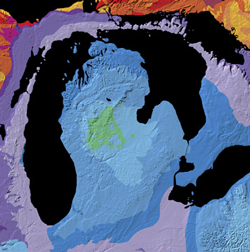
GPS PHOTO LOCATION : 44.777646, -80.979624








Decimal Latitude/Longitude: 44.7773879771365 -80.9682633534233
Landform:
Slough of Despond ANSI is a former bay of glacial Lake Algonquin during the North Bay Interstadial. barriers were constructed across the mouth of the embayment. The deposition of material was controlled by the configuration of the Niagara escarpment as shown by the outward growth of bars. [Earth Science Database, 1998] The upper portion of the Niagara Escarpment is exposed in the Slough of Despond ANSI in the vertical cliffs of Esther's Cliff and Skinner's Bluff above a deep talus slope. It consists of the Lions Head and Wiarton/Colpoy Bay members of the Amabel Formation. A narrow exposure of the Manitoulin Formation occurs at the brow of a wide subordinate scarp formed by a bedding plane exposure of that unit below the main Amabel bluff. The intervening units, the Cabot Head, Dyer Bay, Wingfield, and Fossil Hill Formations, are present in scattered outcrops below low, protected sections of the Amabel bluff and in some roadside outcrops. The bedrock bluffs of the upper escarpment enclose two small wetlands at the head of the re-entrant valleys, the larger of which, an open pond surrounded by a wooded wetland, is known as the Slough of Despond. The wetlands are enclosed by a massive abandoned (raised) beach complex. The maximum elevation of this feature, at about 240 m above sea level (asl), indicates that it was formed in the main phase of glacial Lake Algonquin. The beach complex represents a baymouth bar, enclosing the two small lagoons against the bedrock walls of the re-entrant valleys. Buried organic remains from the sediments in the Slough of Despond are being studied for their role in deciphering postglacial environments of the area. [Kor 1992]
Representation:
The ANSI incorporates one of the best examples in the province of an extensive, abandoned constructional shoreline feature, a baymouth bar/beach and lagoon complex formed in glacial Lake Algonquin. The features of the site make a significant contribution to the shoreline process theme, and to the elements which define the history and processes in glacial Lake Algonquin. These features, including the elements which define their environment of deposition (the surrounding rock bluffs of the escarpment; the Manitoulin "shelf" and bluff; the enclosed lagoons) are considered provincially significant. [Kor 1992]
---
The bedrock bluffs of Skinner’s Bluff and Esther’s Cliff (known locally as Esther Bluff) enclose two small wetlands, the larger of which, an open pond surrounded by a wooded wetland, is known today as the Slough of Despond. The wetlands are enclosed by a massive abandoned (“raised”) beach complex to the north. The elevation of this feature, at about 240 metres above sea level, indicates that it was formed in Lake Algonquin, the precursor of Georgian Bay, immediately after the retreat of the glaciers. The beach complex represents a baymouth bar, enclosing the two small lagoons against the bedrock walls.
Esther’s Cliff & Skinner’s Bluff overlook the Slough & are over sixty metres high. They are two of the thickest vertical bedrock sections exposed along the Niagara Escarpment between Cape Croker and the Blue Mountains.
At the time of glacial Lake Algonquin, the Slough of Despond was located at the north end of a large island. Across the northern tip of this island, a massive baymouth bar/beach complex grew, a result of the vigorous shoreline environment in this exposed area. Baymouth bars are characteristic of gently shelving, emergent coasts which are undergoing a progressive, relative lowering of water level. The abundance of debris available for the bar construction was the rubbly dolostone eroded from the brow of the scarp. Its creation began because of the westward longshore transport of the debris eroded from the bluff. Today along the Bruce Trail in the Bruce Peninsula, such “baymouth bars” can be seen clearly at Barrow Bay and at Cooney’s Dump in the National Park.
Behind the baymouth bar, the Slough was an Algonquin lagoon, an ideal setting for the accumulation of sediment and organic matter which today gives us some insight into the postglacial history of the region, specifically its climatic and environmental conditions. There are only a few such sites in the province and Dr. J. McAndrew of the Royal Ontario Museum has taken sediment cores to study these features.
In the postglacial period, the Slough was likely a dry mudflat environment as the Slough drained after the Algonquin lake levels dropped and abandoned the baymouth bar complex. The present high standing water conditions in the Slough may be the result of a rise in the water table attributed to deforestation in historic times.
On the crest of a number of the highest ridges on the eastern portion of the baymouth bar are small circular depressions about 2 m in diameter. Not a natural creation, these resemble Pukaskwa pits found around the Great Lakes and created by native Americans.
Kor concludes his report: The Slough of Despond is “one of the best examples in Ontario of an extensive abandoned constructional shoreline feature, a baymouth bar/beach and lagoon complex formed in glacial Lake Algonquin.” He recommends that it “should be highlighted as one of a series of sites which illustrate the glacial geology of Ontario, modelled after the Ice Age Trail in Wisconsin.” Recently the Conservation Authority has been acquiring additional property in the area, and the Sydenham Club executive has been approaching landowners for permission to locate the Bruce Trail on their property. Currently the Trail as it heads south follows on top of the bluffs with a long-distance view over the Slough, but then must continue on a lengthy stretch of unattractive road to the south of Halliday Hill. The goal of the Club is to create a Trail which might even be able to circle the Slough, thus opening up this fascinating geological resource to hikers and naturalists. We hope to be able to bring you subsequent progress reports as we work towards this goal.







No comments:
Post a Comment